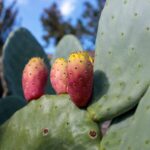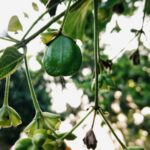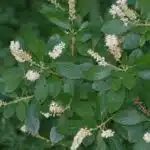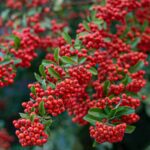Natal plums are an attractive and hardy species of evergreen shrub that is native to the coastal regions of South Africa. These plants, which can grow up to 10 feet tall, are prized for their glossy foliage and attractive flowers. Their versatility makes them ideal for a range of landscaping projects, and they make a great addition to any garden. In this article, we will explore the Natal plum plant profile in detail and explain how they can be incorporated into your landscape design.
First, let’s take a look at the physical characteristics of Natal plums. The leaves of these plants are oblong-shaped and measure up to 3 inches long. They have a glossy green color on top with yellowish-green undersides. The stems are woody and often covered with small thorns. Natal plums produce fragrant white flowers that bloom throughout spring and summer, followed by edible fruits that ripen in late summer or early fall.
Finally, let’s explore some of the benefits associated with growing Natal plums in your garden or landscape design project. These plants are known for their drought resistance and low maintenance requirements, making them perfect for busy gardeners who don’t have time for extensive care instructions. Additionally, these plants provide wonderful visual interest all year round with their evergreen foliage and fragrant blooms throughout spring and summer. As such, incorporating Natal plums into your landscaping plans can add beauty as well as practicality to any outdoor space!
Overview Of Natal Plum Plant
The Natal Plum is an incredible plant of boundless beauty and resilience, endowed with the capability to thrive even in difficult conditions. It offers a unique splendor that not many plants can match. An evergreen shrub, it is a popular choice for gardeners who wish to add a charming touch to their outdoor spaces. Native to the coastal regions of South Africa and Swaziland, this hardy plant grows up to three meters tall and displays ornate foliage and delicately fragrant flowers. Its white-pink blossoms appear from spring until late summer, followed by purple-red berries which are edible but quite sour in taste. This remarkable plant can be grown in full sun or partial shade and requires regular watering during dry spells. With its evergreen leaves and striking flowers, it provides year-round interest making it an ideal addition to any garden.
The Natal Plum is easily recognizable due to its characteristic leaf pattern which consists of three leaflets with serrated edges arranged in pairs on short stalks. Its bark is brownish-gray in color with prominent raised lenticels that help the plant breathe. Furthermore, its small white flowers have five petals while the round purple fruits are usually around two centimeters in diameter when fully ripened. In addition, this species also produces yellow latex sap that oozes out of any cuts or damaged parts of the trunk or branches as a protective mechanism against insects or diseases.
The Natal Plum adds undeniable beauty to gardens with its lush green foliage, exquisite blossoms and tasty fruit which make it a great option for anyone looking for a low maintenance yet attractive specimen for their outdoor space. It also does well in containers so whether you’re looking for something permanent or temporary, this plant could be just what you need!
Identification Of Natal Plum Plant
The Natal Plum is a delightful addition to any garden. It’s a wonderful sight to behold, with its lush foliage and vibrant flowers. Introducing it into your garden space can be an enriching experience for the senses.
Identifying the Natal Plum is not always straightforward, but with a few tips and tricks you can spot this gorgeous plant in no time! Its glossy leaves are oval-shaped and have smooth edges, while its blooms are white or pink and have five petals each. The plant has red fruits that are about 1-2 inches long and look like plums. It also has small thorns on its trunk which makes it easy to recognize from other plants in the area.
In order to make sure you have the right plant, it’s important to pay attention to the details of the foliage and flowers. Look out for the glossy leaves, distinctive petals of the blooms, and telltale thorns on its trunk – these will help you identify whether you’re looking at a Natal Plum or not! With these features in mind, you’ll be able to add this unique beauty to your garden with ease.
Planting Natal Plum
The Natal Plum plant is an exotic and beautiful species that requires some special considerations when it comes to planting. It prefers a spot in full sun, with well-draining soil that’s slightly acidic and rich in organic matter. The best time to plant is during the spring, once all danger of frost has passed and the temperatures have begun to warm up.
When planting the Natal Plum, you’ll want to dig a hole twice as wide as the container the plant was purchased in, but no deeper. If you find your soil doesn’t drain well you may need to add more sand or compost material to help improve drainage. Carefully remove the plant from its pot and place it into the prepared hole ensuring that its at the same level it was originally planted at. Backfill around the root ball with your prepared mixture of soil and compost, then give it a good soak with water.
Mulching around your Natal Plums helps retain moisture around their roots which is particularly important during hot, dry spells. Adding a layer of mulch also helps prevent weeds from growing near them – just be sure not to pile it too high against their stems as this can cause rot. Now that your Natal Plums are planted correctly, they should start establishing quickly so they can begin providing you with lush foliage and delicious fruit!
With correct planting in place, all that’s left for you to do is provide them with adequate growing requirements for them to thrive – including plenty of water and fertilizer during warm months – and prune away any dead or dying branches so they stay healthy year-round.
Growing Requirements For Natal Plum
Growing requirements for Natal Plum is like a puzzle with many pieces which require careful consideration. As a specialist in botany and gardening, I recommend taking the time to ensure that all the elements are in place before planting this delightful fruit-bearing shrub.
The Natal Plum requires full sun, so positioning it near a south- or west-facing wall can help it thrive. It prefers moist, well-draining soil and will not tolerate standing water. A warm climate is necessary to encourage fruiting, so take steps to provide protection from cold winds in cooler areas. Pruning should be done after flowering, as early pruning may reduce yields of delicious plums that ripen in late summer and autumn.
It’s important to note that Natal Plum is an evergreen shrub and can quickly outgrow its space if not pruned regularly. To keep your shrub looking attractive and prevent overcrowding, use hedging shears or prune lightly with hand shears on an annual basis. With the proper care and attention, you can enjoy the fragrant flowers and sweet fruit of your Natal Plum for years to come.
Location Considerations For Natal Plum
The Natal Plum is an attractive shrub, and a great choice for gardeners wanting to add vibrant color to their landscape. However, choosing the right location is key to its successful growth. To ensure it thrives in your garden, here are some important location considerations when planting a Natal Plum.
First of all, this plant enjoys plenty of sunlight and prefers at least 6 hours of direct sunlight per day. It should be planted in a well-draining soil that’s been amended with compost or other organic matter, as it doesn’t thrive in overly wet conditions. While it can tolerate slightly acidic soils, it prefers neutral soils with an ideal pH range between 6.5 – 7.5.
In terms of temperature, the Natal Plum is winter hardy down to 20° F (-6° C). It does not do well in hot climates and should be grown in cooler areas where temperatures do not exceed 95° F (35° C). If you live in a particularly hot region, you may want to consider planting it on the east side of your home where it will receive morning sun but be shaded from the harsh afternoon sun.
To ensure your Natal Plum gets off to a strong start and continues to thrive for years to come, make sure you select an ideal location that meets its specific growing requirements. With the right care and attention, this plant can bring beauty and color to any garden!
Watering And Fertilizing Natal Plum
The Natal Plum is a symbol of resilience and courage. It stands tall, evergreen and dignified in the face of any obstacle it may encounter. This hardy shrub can be found in many gardens across the world, adding a touch of vibrancy with its deep green leaves, fragrant flowers and bright red fruits.
To ensure your Natal Plum thrives, there are some key considerations when it comes to watering and fertilizing:
Watering: The Natal Plum needs weekly watering for optimal growth. When watering make sure to avoid wetting the foliage as much as possible.
Fertilizer: If a fertilizer is needed, use one that contains nitrogen such as one with a ratio of 10-10-10 or 20-20-20. Apply every four to six weeks during the growing season or according to package instructions.
Mulching: Mulch around your Natal Plum with organic material such as compost or bark chips to help retain moisture and reduce weeds.
By following these simple tips you can ensure your Natal Plum will thrive in any garden setting while providing seasonal beauty year after year! With proper care, this resilient shrub will become an integral part of your outdoor oasis – now onto pruning and training…
Pruning And Training Natal Plum
Caring for the natal plum requires more than just watering and fertilizing. Pruning and training are essential steps in producing a beautiful, healthy plant. It’s no wonder that gardeners around the world have come to appreciate this evergreen shrub as an ornamental addition to their outdoor spaces.
Pruning may seem intimidating at first glance, but with a bit of practice and patience, it can be a rewarding experience. Whether you’re maintaining an established plant or trying to shape a new one, careful pruning is key. Start by removing any dead or dying branches and then thinning the canopy to allow for better air circulation. You can also remove any crossing branches and use selective pruning to create your desired shape.
When it comes to training, there are several techniques you can use depending on the desired outcome. If you want a natural-looking shrub, you can use staking or tying down branches with flexible ties. For an espalier-style silhouette, consider wiring young stems onto trellises or frames so they grow into the desired shape over time. In any case, keep in mind that natal plums are relatively slow growers, so you’ll need to be patient as your work takes shape!
Controlling Pests And Diseases On Natal Plum
It’s as if the Natal Plum was cursed. Everywhere you look, it is beset by pests and diseases. From the smallest spider mite to the most pervasive fungal disease, these little plants have it all. And with no natural defenses apart from their thick leaves, they’re particularly susceptible to attack. As such, controlling pests and diseases on Natal Plums is a daunting task that requires diligence and constant vigilance.
Fortunately, there are many ways to keep your Natal Plum free from harm. The first step is to ensure that your plants are planted in well-draining soil and kept in an area with plenty of air circulation. This will reduce the chances of fungal diseases taking hold in the plant’s roots or leaves. Additionally, regularly pruning off any dead or diseased branches or leaves will help keep the plant healthy and pest-free. Finally, you can use insecticides or fungicides as necessary to protect your Natal Plum from harm – but always be sure to follow application instructions carefully!
With a bit of careful planning and regular maintenance, you can keep your Natal Plums safe from harm and enjoy their beauty for years to come. From proper planting techniques to regular pruning and pesticide use, there are many steps you can take to make sure your beloved plants stay healthy and vibrant throughout their lives. Now let’s move on to harvesting and storing this incredible fruit…
Harvesting And Storing Natal Plum
Harvesting and storing natal plum is a rewarding task for the diligent gardener. It requires knowledge of the fruit’s life cycle, as well as an understanding of how it should be handled properly. Here are three key points to consider when harvesting and storing natal plum:
Timing is important – Natal Plum ripens in the late summer or early autumn months and should be harvested when fully ripe. To check if they are ready, use your fingertips to gently press the skin of the fruit; if it yields slightly to pressure, then it’s ready to be picked.
Proper handling is essential – Handle with care while picking, as too much pressure can cause bruising that will affect its taste or shelf life. Place freshly harvested fruits in shallow trays or boxes lined with newspaper for transport.
Store at optimal temperatures – Natal Plum can be stored at room temperature for a few days if you plan on using them soon, but for longer storage, keep them in the refrigerator. This will help preserve their flavor and texture for up to two weeks.
By following these steps, gardeners can ensure that their Natal Plum harvest is both delicious and long-lasting. The next step is taking advantage of all this juicy goodness by finding creative ways to use this delightful fruit!
Uses For Natal Plum
Natal plums are a delicious, easy-to-grow fruit that can add a sweet flavor to many dishes. They’re also an incredibly versatile plant, with numerous uses for their fruit and leaves. Here’s how you can use this delightful plant in your kitchen:
• Make jams or jellies: Natal plums are perfect for making homemade jams and jellies. The sweet-tart flavor of the fruit is a great accompaniment to toast or biscuits.
• Add flavor to salads: The leaves of natal plum plants make a great addition to salads. They add an interesting and unique new dimension to your favorite salad ingredients.
• Use as a garnish: The small, round fruits of the natal plum tree make excellent garnishes on cakes and desserts. They look lovely and add extra flavor too!
These are just some of the ways you can utilize this hardy little tree in your kitchen. Natal plums offer both convenience and flavor, making them an ideal choice for cooks looking for something unique and delicious. With a bit of creativity, you can find many other ways to put this tasty little fruit to use in your cooking!
Benefits Of Growing Natal Plum
Growing the Natal Plum is like painting a masterpiece. It’s a captivating and rewarding experience that has countless benefits. From providing a beautiful display of colorful foliage to offering delicious fruit, there’s no doubt that this plant provides many advantages. Let’s take a look at why it pays off to have a Natal Plum in your garden!
First, the Natal Plum makes an excellent addition to any landscape design. Its vibrant green leaves are contrasted by its bold purple flowers, creating an eye-catching display that will surely stand out in any garden. This evergreen shrub also produces delicious fruits during the summer months, making it perfect for those who enjoy cooking with fresh ingredients.
The Natal Plum is also very easy to care for. This hardy shrub requires little maintenance and can thrive in both sunny and partially shady spots. Plus, it’s known for being drought-tolerant and can tolerate even the harshest of climates with ease. With its minimal upkeep requirements, growing this plant makes for an ideal choice for those who want to spruce up their outdoor space without having to invest too much time into caring for it.
All these features make the Natal Plum an attractive option for any gardener looking to add some beauty and bounty to their outdoor space! Not only will you be able to enjoy its gorgeous foliage and delicious fruits but you’ll also be able to relax knowing that your plant won’t require too much effort on your part. From its stunning visual appeal to its minimal maintenance needs, adding a Natal Plum into your garden is sure to bring many rewards!
Challenges Of Growing Natal Plum
The Natal Plum is a wonderful addition to any garden, but it does come with some challenges. As a botanist and gardener, I’d like to take this opportunity to share my insights on the potential difficulties associated with growing this plant.
First, the Natal Plum is native to southern Africa and can be quite finicky in non-tropical climates. It requires warm temperatures of at least 60 degrees Fahrenheit and dislikes cold drafts or frost. In addition, they need plenty of sun, so it’s important to be mindful of where you decide to plant them if you live in areas that don’t get much sunshine.
Second, these plants are also susceptible to certain pests such as aphids and mealybugs which can cause irreversible damage if not treated quickly. They also require frequent watering in order for them to remain healthy and produce attractive fruits. Lastly, keep in mind that the sharp thorns on the branches can be especially dangerous for small children or pets who might accidentally brush up against them while playing outdoors.
Overall, while there are some challenges associated with growing the Natal Plum, they can still make a great addition to any garden with proper care and attention. With the right conditions and regular maintenance, you’ll be able to enjoy these gorgeous shrubs for many years!
Companion Plants For Natal Plum
The Natal Plum is a great addition to any garden, providing a splash of color and texture to the landscape. But in order for it to thrive, it may be beneficial to select companion plants that play well with the Natal Plum’s needs. Here are some of the best companion plants for this ornamental shrub:
Dianella tasmanica – Also known as Tasman Flax Lily, this evergreen plant works well when planted alongside Natal Plums as it provides a good contrast in terms of color and texture. It also requires similar soil conditions and watering requirements.
Grevillea – Grevillea is an Australian native that can make a great companion for Natal Plums. The foliage provides excellent contrast for the plum’s glossy green leaves, while its bright flowers offer an eye-catching display during blooming season. Plus, its low water requirements mean it won’t compete with your Natal Plums for resources.
Callistemon – This flowering shrub brings plenty of colors to your garden and provides an interesting contrast to the shape of your Natal Plum’s leaves and branches. Also, its drought-tolerance means you won’t have to worry about over-watering it or competing with your plum bush for resources in dry weather conditions.
These plants make great companions for the Natal Plum due to their ability to provide visual interest while not competing with the plum bush in terms of water or soil requirements. When choosing companion plants for your Natal Plum, look out for those that offer different colors, textures, shapes and sizes so you can create an attractive garden display while still meeting all of your plant’s needs. Additionally, selecting plants that are native to your area will ensure they can adjust easily and grow without too much effort on your part! With careful selection of companions for your Natal Plum bush, you can create a unique garden display that will both attract attention and be easy to maintain!
Alternatives To Natal Plum
As the old saying goes, ‘A change is as good as a rest.’ Alternatives to natal plum can be very beneficial in garden design. With their small size and bushy or vining nature, these plants offer an interesting variety of foliage and flowering options that can add both beauty and a sense of structure to the garden. As an experienced botanist and gardener, I’d like to share a few of my favorite alternatives for you to consider when looking for a replacement for natal plum.
For starters, shrubs such as dwarf camellias, azaleas, or even junipers are great options. These shrubs tend to be evergreen, so they provide year-round interest in the landscape. Some varieties also produce beautiful blooms that add color throughout the spring and summer months. Additionally, many of these shrubs have attractive foliage year-round that will give your garden texture and interest with minimal effort from you.
Vines are also excellent alternatives for replacing natal plums in your garden. For example, Boston ivy has attractive foliage that turns an eye-catching shade of red in fall. It’s also easy to maintain with regular pruning – simply make sure you trim it back each spring before it begins to grow too much or starts overtaking its neighbors! Additionally, trumpet vine is another great option if you’re looking for something more showy; this vine produces bright orange flowers during the summer months that will draw plenty of attention from passersby!
These are just some ideas that can help spice up your garden while still providing structure similar to what natal plums would have provided. Consider giving one (or more) of these alternative plants a try – they may end up being even better than natal plums!
Tips For Growing Natal Plum
Like a beacon of light, the Natal Plum is a gorgeous addition to any garden. Its vibrant pink and white flowers, along with its succulent fruit, make it an alluring choice for even the most novice of gardeners. To ensure that your Natal Plum is as healthy and happy as possible, here are some tips for growing this exotic beauty.
First and foremost, the Natal Plum needs plenty of sunlight in order to thrive. Plant it in an area that receives at least six hours of direct sunlight each day. Additionally, be sure to water it regularly and avoid over-watering; too much moisture can quickly cause root rot or other fungal issues. Regular pruning will also help your plant stay healthy and encourage more blooms during the growing season.
When adding soil amendments to your Natal Plum’s bed, use organic matter like compost or manure to provide additional nutrients for the roots. A thick layer of mulch will help keep moisture in place during hot summer months and reduce weed growth around the base of your plant. Lastly, make sure you fertilize your plant twice a year with a balanced fertilizer specifically designed for flowering plants like the Natal Plum.
By following these simple guidelines, you’ll be well on your way to having a thriving Natal Plum in your garden. With just a bit of care and attention, you can enjoy its beauty for years to come!
Frequently Asked Questions
How Long Does It Take For Natal Plum To Reach Maturity?
The Natal Plum is a captivating species, with its unique shape and vibrant color. It is an ideal addition to any garden, with its rapid growth rate and hardy nature. But just how long does it take for this plant to reach maturity?
Growing this ornamental fruit tree generally takes around three years from planting to full maturity. This period of growth varies according to the climate of the region in which it is being planted; in colder climates, it may take four years for the Natal Plum to reach full maturity. During this time, the plant should be watered regularly, but not extensively – too much water can cause root rot and other issues that can damage or kill the plant.
The Natal Plum will reward gardeners’ patience with its captivating foliage and delicious fruits once fully mature. Its deep green foliage turns to shades of purple during winter months, while its small white flowers lead way to dark red-to-purple fruits in summertime. With proper care and attention, this delightful species will bring beauty and flavor to any garden!
What Kind Of Soil Should Be Used When Planting Natal Plum?
Gardening with the Natal Plum may seem like a daunting task, but it doesn’t have to be! With the right soil and a bit of TLC, you can have a successful, thriving plant. As a botanist specializing in gardening with this special species of plant, I’m here to tell you that getting your Natal Plum off to a great start begins with selecting the ideal soil.
When it comes to Natal Plums, an incredibly important factor is drainage: the soil must be able to drain water quickly and effectively. It’s best to use sandy loam or slightly acidic soil for planting. This will allow for optimal drainage and prevent water logging, which can lead to root rot. However, make sure that your soil isn’t too dry; if it is, add organic matter such as compost or mulch before planting in order to ensure enough moisture is retained.
If you’re still uncertain about what kind of soil may work best for your Natal Plum, there are many resources available online or at your local garden center that can help guide you. Additionally, it may be beneficial to consult an experienced gardener or professional horticulturalist who can provide personalized advice on selecting the right soil for your particular situation.
No matter what kind of soil you eventually choose for planting your Natal Plum, one thing is certain: when given appropriate care and attention in well-draining soil, these plants are sure to thrive!
Are Natal Plum Plants Edible?
The Natal Plum, known by its scientific name Carissa macrocarpa, is a hardy flowering shrub found in many parts of Africa and India. It has a delicate, sweet fragrance that is said to evoke memories of faraway lands. But what few know is that it’s also edible!
The leaves of the Natal Plum are dark green, rich in antioxidants and vitamins A and C. The fruit is also edible and can be enjoyed when fully ripe. The sweet taste makes it an attractive addition to salads or desserts. It can also be juiced for a refreshing drink.
Natal Plum grows best in well-drained soil with ample sunlight, but it does not require much maintenance overall. With the right care, you can enjoy these fruits for years to come! All in all, this plant offers both beauty and sustenance – a truly rewarding combination.
How Often Should Natal Plum Be Watered?
Natal plum plants are a popular choice for gardeners who want to add a touch of exotic beauty to their outdoor space. As these plants require specific care, it is important to understand how often they should be watered in order to ensure healthy growth. Here’s what you need to know:
Natal plums typically need watering every two weeks. This frequent watering ensures that the soil around the plant stays moist and nutrients can be absorbed more easily. During hot weather, however, they may need more frequent watering.
The amount of water needed by natal plum depends on the size of the plant and its location. If it is planted in full sun, it needs more water than if it is planted in an area with partial shade. It’s important to also consider local rainfall when determining how much water your natal plum needs.
To check if your natal plum needs watering, stick your finger into the soil around the base of the plant up to knuckle-depth and see if it feels dry or damp. If it’s dry, then your natal plum needs water; if it’s damp or wet then there’s no need for additional watering at this time.
For best results, choose a potting mix containing a high proportion of organic matter for planting natal plums and make sure that you’re providing sufficient drainage so any excess moisture can escape quickly. Monitor your plant’s watering requirements regularly as these may change depending on seasonality and environmental conditions, but with regular attention and proper care you can enjoy lush foliage and vibrant flowers year-round!
Is Natal Plum Tolerant Of Extreme Temperatures?
The Natal Plum is an evergreen shrub native to South Africa, and is often used as a hedge plant in warmer climates due to its attractive foliage and fragrant flowers. It’s certainly an asset for your garden but it’s important to know if it can tolerate extreme temperatures. This article will explain how the Natal Plum fares in extreme temperatures.
First, let’s talk about temperature tolerance. The Natal Plum can withstand cold temperatures down to 20 degrees Fahrenheit (-7 Celsius). This makes it ideal for colder climates, where it can be grown outdoors year-round and will still thrive. However, when temperatures drop below 20 degrees, you may need to provide some protection by covering the plant with a sheet or frost cloth.
On the other hand, the Natal Plum has also been known to endure high temperatures up to 115 degrees Fahrenheit (46 Celsius). With this in mind, it’s essential that you provide adequate shade for your plant during hot summer months, as well as plenty of water. It’s also important to note that while the Natal Plum is tolerant of extreme temperatures, this doesn’t mean that it will thrive in them – providing proper care is key for keeping your plant healthy.
In short, with proper care and attention the Natal Plum can survive and even thrive in both cold and hot conditions. However, if you live in an area with extreme weather conditions, extra steps may need to be taken in order to ensure its health. Make sure you monitor your plants closely during periods of extreme temperature shifts so that you can take any necessary action if needed.
Conclusion
The Natal Plum is an amazing and resilient plant that can bring beauty and life to any garden. Its deep red fruit are symbolic of the strength and determination it takes to thrive in such a challenging environment, while its glossy leaves symbolize the joys of gardening. With the right soil and regular watering, your Natal Plum will reach maturity in just 3-4 years. It’s also tolerant of extreme temperatures, making it an ideal addition to any home garden.
It’s hard not to bring out the poetic side when talking about this amazing plant. Not only does it look beautiful, but it has also been known to provide sustenance for people in times of scarcity. The fruit may be small, but its significance is much greater than its size – a reminder that life’s greatest gifts often come from unexpected places.
The Natal Plum is truly a remarkable plant that deserves more attention than it gets. With proper care and attention, you can bring this piece of nature into your own home and enjoy its beauty year-round. Whether you choose to eat the fruit or simply admire its beauty from afar, this plant will make sure to reward you with its resilience and hardiness each season!





























